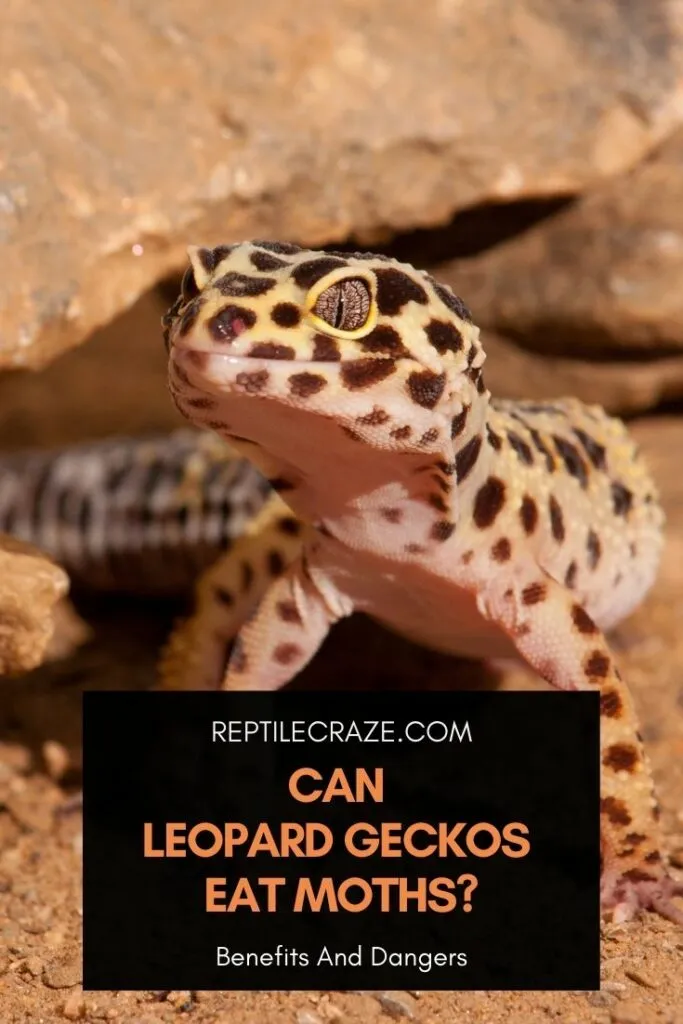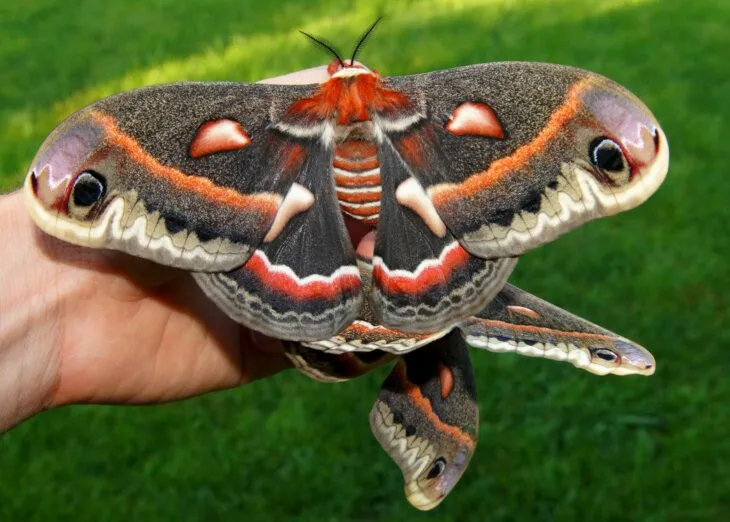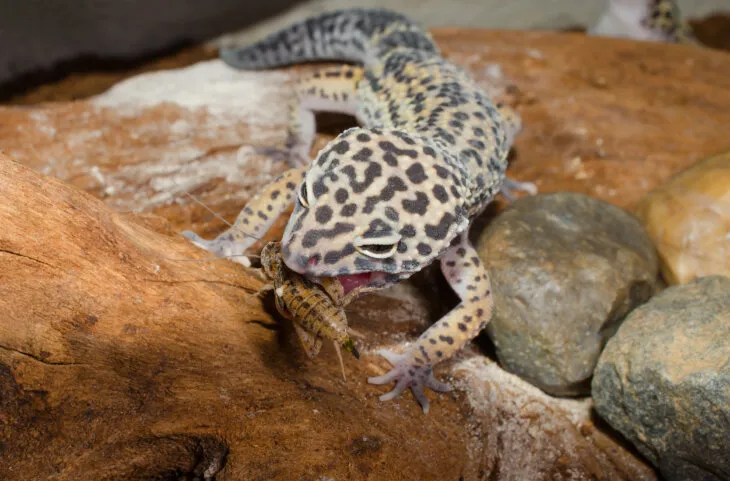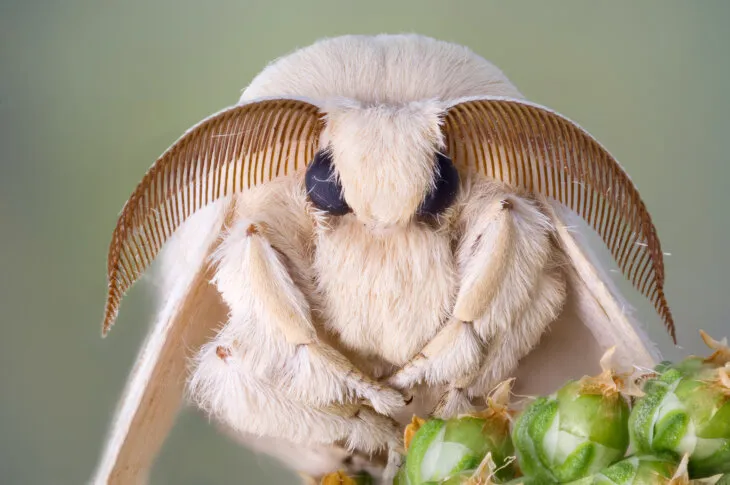
As Leopard Gecko (Eublepharis macularius) owners, it is our responsibility to give our pets a suitably nutritious, insectivorous diet. We also need to keep our pets mentally and physically stimulated. Could hunting moths give them exercise, a mental challenge, and a good meal, all at the same time? Let’s find out whether Leopard Geckos can and should eat moths.
Leopard Geckos can eat moths but they should only be fed safe species of moths from captive-bred larvae. Wild moths carry the risk of pathogens and pesticides. Moths don’t have an ideal nutritional profile and should be fed as rare treats. Moths should be given as they provide enrichment.
That’s the quick answer, but there’s a lot more to learn about which moths you can feed your Leopard Gecko, and where you can get them. Read on to discover how to give moths to your Leopard Gecko safely.
Table of Contents
Leopard Geckos Can Eat Moths
Leopard Geckos are insectivores. This means that they are carnivores that usually only eat insects. However, when they need to, they may eat other tiny animals.
Leopard Geckos must eat other animals and cannot get the nutrients that they need from plant-based foods.
Moths are part of the insect class and they are a paraphyletic group. This means that all moths have one common evolutionary ancestor. Moths make up all the members of order Lepidoptera that are not butterflies.
Leopard Geckos can eat moths. But, they can’t eat all moths. Some species of moths may be toxic. Some moths may carry bacteria or parasites that could endanger your Leopard Gecko.
Moths Are Not Very Nutritious To Leopard Geckos
It is very difficult to find or provide any nutritional values for adult moths. But, moths are less nutritious than their larvae. Here’s why…
What Is The Difference Between Moths And Caterpillars/Worms?
Larvae are usually called caterpillars, or sometimes worms. The larval (or instar) stages of the animal’s life are the longest. Larvae contain a lot of fat.
They are eating a lot to build up fat reserves in preparation to spin cocoons. They then become a pupa and transform into moths.
The winged moths that you see at night represent the adult, and last, stage in the life cycle of that species. The moth stage is for reproduction. Reproduction is usually sexual, requiring both a male and a female.
The moth stage of the animal’s life cycle is very short. Some moths may feed on nectar during this time to sustain themselves, but some moths do not eat at all! Moths don’t contain as large amounts of fat as their larval stages do.

What Do We Know About The Nutritional Value Of Moths?
There is almost no nutritional information available for adult moths. However, what we can conclude is that they contain less fat than their larval life stage, as they eat very little beyond that point.
But, the adult moth is still fatty. It lives off these energy reserves as it flies around looking to mate. Indigenous Australian people would eat Bogong moths as they were a rare resource for fat in the Australian outback.
Moths are also lower in calcium than larvae and pupa, according to research on the Eastern tent moth. They also contain protein, but the amount is unknown.
The Benefits Of Feeding Moths To Leopard Geckos
The benefits of feeding moths to Leopard Geckos include enrichment and exercise, but not a lot of good nutrition.
Moths make much better sport than worms do when it comes to hunting. Your Leopard Gecko will have to practice skills such as stalking and catching its prey.
This is very good, as it provides enrichment. Enrichment is an important part of quality animal care. Enrichment means providing variation to the environment that is mentally and physically stimulating.
Hunting will also get your Leopard Gecko moving. Leopard Geckos in captivity have much less need, and less space, to move about than wild geckos. Any motivation to get them exercising a bit is positive.
The Dangers Of Feeding Moths To Leopard Geckos
The dangers of feeding moths to your Leopard Gecko include choking, impaction, and swallowing pathogens. We will cover pathogens and toxicity in more detail later.
Choking And Impaction
Moths present a danger of choking and impaction because they are larger than most other prey. Also, their wings make them an awkward and changeable shape.
Impaction occurs when something is swallowed and becomes trapped in the digestive tract. It will not pass through and causes a buildup of matter behind it.
If your Leopard Gecko suffers impaction, it will not be able to digest any more
The best way to reduce the risk is to select moths that are smaller than the width between your Leopard Gecko’s eyes. This width reflects the width of their throat.

Inappropriate Nutrition
Another danger is nutritional imbalance. Moths should generally not be used as staple feeder insects.
Exact nutritional information is not available, and therefore it is difficult to judge the amount of fat, protein, calcium, and phosphorus that your Leopard Gecko will ingest.
Moths are also difficult to dust with calcium powder, and even more difficult to gut load. Therefore, they are likely to contribute to metabolic bone disease.
To avoid these issues, it is best to feed moths only as sporadic treats, and not as a staple
Biting
Moths do not pose a threat with regard to biting and injuring your Leopard Geckos. Moths do not have teeth and mouths. Instead, most have a proboscis. This is like a tiny curly straw that is used for drinking nectar.
It cannot bite your pet (unless it is a Vampire Moth, whose proboscis can pierce skin!).
Are There Moths That Are Toxic To Leopard Geckos?
Yes. Some moths have developed defenses against being eaten by predators.
For example, some moths have developed tiny spiny hairs that can lodge in the skin and cause irritation. But, it is much more common for caterpillars to have these than adult moths. They can cause a painful reaction of redness and bumps.
Don’t feed your Leopard Gecko any moths that have visible spines. Hairs are more difficult to assess as being risky or not, as many moths are hairy.
Most moths are not toxic. The few species of moths that can be poisonous when eaten usually get their toxicity from toxic plants that they eat during their larval stage.
Their level of toxicity is not high and can’t kill a human. But, a little Leopard Gecko may be more severely affected.
Can Leopard Geckos Eat Wild Moths?
No. It is a very bad idea to catch and feed wild moths to your pet Leopard Gecko. Firstly, because you are unlikely to know which species of moth you’re catching and whether it is harmful.
Secondly, because the wild moth may carry any of the following…
Diseases
Wild moths may be suffering from diseases or infections. If your Leopard Gecko eats it, he could suffer from these pathogens too.
Parasites
Moths face a constant struggle against parasites at all stages of their life. Feeding your Leopard Gecko parasitized moths will expose them to the same parasites. Very little is known about how these might affect your Leopard Gecko.

Pesticides And Fertilizers
Feeding wild moths to your Leopard Gecko puts them at risk from ingesting chemicals. Wild insects are often coated with chemical insecticides or fertilizers that they encounter. These can be poisonous to your Leopard Gecko.
Can Leopard Geckos Eat Wax Moths?
Yes. Leopard Geckos are perfectly safe to eat wax moths (Galleria mellonella), also known as honeycomb moths. Many Leopard Geckos receive wax moths as treats because wax worms (the larval stage of wax moths) are so commonly kept as feeder insects.
Find out more about how Leopard Geckos can eat wax moths in our detailed guide.
Can Leopard Geckos Eat Bee Moths?
Yes. Bee moths, or bumblebee wax moths (Aphomia sociella), are native to Europe. They can be found throughout Europe and Asia, but have also been spotted in the USA.
Like the wax moth, they seek out hives of bees to parasitize. Bee moths prefer to target bumblebees. They lay their eggs inside so that their larvae can eat the wax. Bee moths are a pest and endanger bumblebees.
Bee moths are typically 1.8-4 cm wide with their wings open. Interestingly, they often play dead when threatened. This works well against wasps and bees. But, it may make them easier for Leopard Geckos to hunt.
There is no reason that these moths should be toxic or harmful to your Leopard Gecko, provided that they are correctly fed on honey and grains in captivity. You can get bee moths by buying bee moth wax worms and allowing them to pupate.
Can Leopard Geckos Eat Silk Moths?
Leopard geckos can eat silk moths. These moths have been domesticated for thousands of years. The domestic silk moth (Bombyx mori) is a very important insect for humans. The larvae, or silkworm, spins silk that we use as premium fabric.
Domestic silk moths cannot fly and make easy prey for your Leopard Gecko. But, beware that these moths are large, They can have a wingspan of 4-5cm, so these are only suitable for large Leopard Geckos.
Silkworms are eaten by humans in some cultures. The species is not toxic and has a better nutrient profile than most other larvae. You can easily buy silkworms as feeder insects and allow them to pupate and turn into silk moths.

Can Leopard Geckos Eat Chilean Moths?
Yes, but you probably won’t be able to find any to feed. The Chilean moth (Chilecomadia moorei) is the adult form of the butterworm. Butterworms are often used as feeder insects for Leopard Geckos and as fishing bait.
They are not toxic and can be fed to your Leopard Gecko. However, the adult moth is an invasive species outside of Chile. For this reason, the butterworms are often irradiated so that they cannot pupate.
You are unlikely to find Chilean moths for sale outside South America and will probably not be able to get them from buying butterworms.
Can You Buy Moths As Feeder Insects For Leopard Geckos?
It is not common to find moths available to buy as feeder insects. Leopard Gecko owners usually buy the larval form of the moth, for example, wax worms, silkworms, or bumblebee wax worms.
If you store the larvae at room temperature, and not in the fridge, they will begin to pupate and transform within a few weeks. You may need to provide some
Provide a blend of honey with oat baby
Could Leopard Geckos Be Scared Of Moths?
It is very unlikely that your Leopard Gecko will be scared of moths. They have a strong drive to hunt, and this will almost certainly kick into action when they see a flapping moth.
But, it is reasonable that they might be afraid of a moth that is far too large. Select small moths for your Leopard Gecko, and watch him enjoy being a voracious little predator.
- Eastern Rat Snake: Nature’s Pest Control and Fascinating Reptile - September 20, 2024
- Eastern Racer: The Fast and Agile Snake - September 19, 2024
- The Eastern Indigo Snake: The Majestic, Non-Venomous Hunter of the Southeast - September 18, 2024
